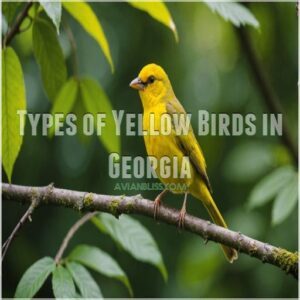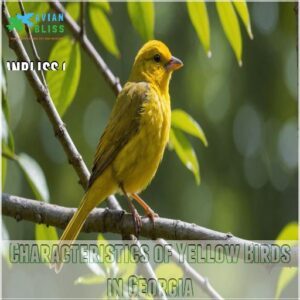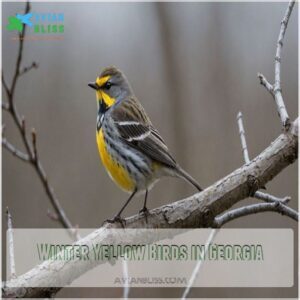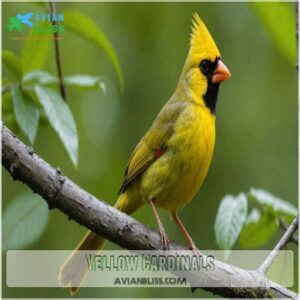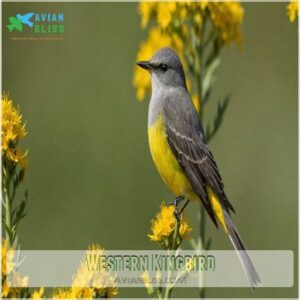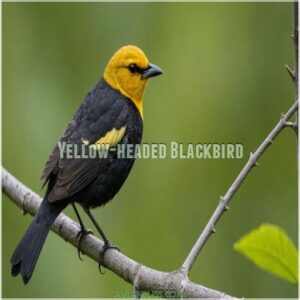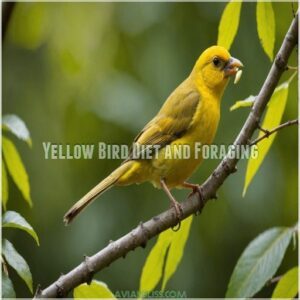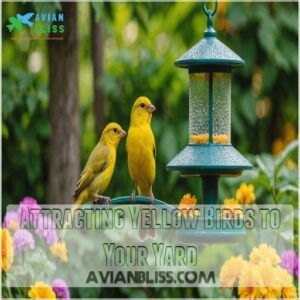This site is supported by our readers. We may earn a commission, at no cost to you, if you purchase through links.
 If you’re wandering through Georgia’s backyards or forests, don’t miss the vibrant yellow birds that could brighten any cloudy day.
If you’re wandering through Georgia’s backyards or forests, don’t miss the vibrant yellow birds that could brighten any cloudy day.
You’ll likely spot the American Goldfinch, wearing its black-tipped wings like a little tuxedo.
The Pine Warbler adds melody to the woods, while the Summer Tanager’s yellow cousin, the Western Kingbird, often steals the show with its lively antics.
Whether it’s the sweet song of the Yellow Warbler or the cheerful chatter of the Yellow-Breasted Chat, these sunny fellows remind you that nature’s tiny treasures are often the most delightful.
Curious about more yellow wonders in Georgia? Stick around!
Table Of Contents
- Key Takeaways
- Types of Yellow Birds in Georgia
- Characteristics of Yellow Birds in Georgia
- Year-Round Yellow Birds in Georgia
- Summer Yellow Birds in Georgia
- Winter Yellow Birds in Georgia
- Migratory Yellow Birds in Georgia
- Rare Yellow Birds in Georgia
- Yellow Birds by Habitat
- Yellow Bird Diet and Foraging
- Attracting Yellow Birds to Your Yard
- Frequently Asked Questions (FAQs)
- What is a yellow bird in Georgia?
- Are there Red Birds in Georgia?
- How do you identify birds in Georgia?
- Are bluebirds spotted all year in Georgia?
- What does a yellow bird look like in summer?
- Are black birds in Georgia migratory?
- How do I identify baby yellow birds?
- What are yellow birds predators?
- Which yellow birds nest in cavities?
- Do yellow birds migrate in flocks?
- What songs do yellow birds sing?
- Conclusion
Key Takeaways
- You’ll spot vibrant yellow birds like the American Goldfinch and Pine Warbler year-round in Georgia, brightening up backyards and forests alike with their striking plumage. American Goldfinches, like those found in Arizona’s desert regions with open areas and scattered trees and shrubs Arizona Desert Goldfinches, are common in many states and are strict vegetarians, feasting on seeds from garden plants and bird feeders.
- Get ready to enjoy birdwatching, as Georgia’s yellow birds engage in fascinating behaviors, from the acrobatic flights of goldfinches to the distinct songs of warblers.
- You can turn your yard into a haven for these feathered friends by planting native vegetation and installing bird feeders and water sources.
- Keep your eyes peeled for rare sightings like the Yellow Cardinal and Yellow-headed Blackbird, which add a unique splash of color to your birding adventures in Georgia.
Types of Yellow Birds in Georgia
You’ll find a vibrant array of yellow birds in Georgia, from the cheerful American Goldfinch to the elusive Yellow-breasted Chat.
These feathered friends come in various shades and sizes, each with unique markings and behaviors.
This makes birdwatching in the Peach State a thrilling adventure.
Common Yellow Birds in Georgia
Georgia’s skies are alive with a dazzling array of yellow birds.
You’ll often spot the vibrant American Goldfinch, a true crowd-pleaser at finch feeders.
Listen for the sweet melodies of Wilson’s and American Yellow Warblers in lush forests.
The versatile Myrtle Warbler might catch your eye with its unique foraging habits.
For a real treat, keep an ear out for the Nashville Warbler’s distinctive song—it’s like nature’s own little symphony!
Yellow Birds With Distinctive Markings
While common yellow birds catch your eye, some species sport eye-catching patterns that’ll make you do a double-take.
Take the Common Yellowthroat, with its dashing black mask, or the Yellow-Breasted Chat’s "spectacles."
These distinctive markings aren’t just for show—they’re nature’s way of saying "Hey, look at me!"
Whether it’s the Magnolia Warbler’s bold stripes or the Northern Parula’s subtle patches, these feathered fashionistas are sure to impress any bird-watching enthusiast.
Yellow Birds With Unique Behaviors
Watching yellow birds in Georgia is like catching nature’s quirky comedy show.
These feathered performers have some truly unique tricks up their wings: American Goldfinches perform acrobatic courtship flights, resembling a rollercoaster ride, and some species, like the Yellow Warbler, migrate long distances to and from their breeding grounds passing through North Carolina’s wetlands.
Wilson’s Warblers bob their tails like excited puppies while foraging.
Yellow-Breasted Chats put on a vocal concert, mimicking other birds and even car alarms.
From nesting habits to migration patterns, each species has its own flair.
You’ll never look at your backyard the same way again!
Yellow Birds With Interesting Habitats
As you explore Georgia’s diverse landscapes, you’ll find yellow birds with fascinating habitat preferences.
These feathered friends have adapted to specific environments, showcasing nature’s ingenuity.
Here’s a glimpse into their unique homes:
| Species | Habitat | Conservation Status | Unique Adaptation |
|---|---|---|---|
| Prairie Warbler | Young pine stands | Near Threatened | Thrives in disturbed areas |
| Yellow-Throated Warbler | Tall trees, open understory | Least Concern | Specialized bill for bark foraging |
| Cape May Warbler | Coniferous woods edge | Least Concern | Curled tongue for nectar feeding |
| Kentucky Warbler | Moist deciduous forests | Least Concern | Ground-nesting camouflage |
These adaptable birds face habitat threats but show remarkable urban adaptation.
Your backyard could become their new hotspot!
Characteristics of Yellow Birds in Georgia
You’ll find Georgia’s yellow birds are as diverse as they’re vibrant, with distinctive markings and behaviors that set them apart.
From the American Goldfinch’s bright plumage to the Yellow-rumped Warbler‘s unique patches, these feathered friends offer a colorful array of characteristics that’ll make your birdwatching adventures truly exciting.
Identification Tips for Yellow Birds
To spot yellow birds in Georgia, you’ll need a keen eye and a good field guide, such as those found in Georgia bird identification resources online birding supplies.
Look for distinctive markings like black caps or streaks.
Notice the bird’s size and shape – is it finch-like or warbler-sized?
Pay attention to habitat clues; some prefer forests, others open fields.
Listen for unique songs, too.
The American Goldfinch’s cheerful "po-ta-to-chip" call is a dead giveaway.
Happy birding!
Yellow Bird Behavior and Characteristics
Georgia’s yellow birds are nature’s little marvels, each with its own quirks and charms. You’ll find their behaviors as varied as their vibrant plumage. From the American Yellow Warbler’s cheerful "sweet-sweet-sweeter-than-sweet" song to the goldfinch’s acrobatic feeder antics, these feathered friends never cease to amaze.
- Nesting habits range from cup-shaped wonders to cavity dwellers
- Seasonal plumage changes turn drab winter coats into summer showstoppers
- Migration patterns vary, with some species braving Georgia’s winters
The Meaning of Yellow Birds
Yellow birds flutter with more than just beauty; they carry rich symbolism across cultures.
From hope and joy in Western folklore to spiritual awakening in Native American traditions, these feathered friends spark curiosity.
Birdwatching communities often swap tales of yellow warblers like the Myrtle or Nashville, seeing them as good omens.
Even the Common Yellowthroat’s cheerful song is said to lift spirits.
Next time you spot a yellow bird, ponder its potential message!
Year-Round Yellow Birds in Georgia
You’ll find two stunning yellow birds in Georgia all year round: the American Goldfinch and the Pine Warbler.
These feathered friends bring a splash of sunshine to your backyard, whether you’re sipping hot cocoa in winter or enjoying a summer BBQ.
American Goldfinch
Let’s talk about the American Goldfinch, a year-round charmer in Georgia’s backyards.
These little finches are like flying rays of sunshine, brightening up your feeders with their vibrant yellow plumage.
But don’t be fooled – they’re not always dressed in their Sunday best.
In winter, they swap their golden suits for a more subdued olive-brown outfit.
It’s like they’re playing dress-up with the seasons!
Here are some fun facts about these feathered friends:
- They’re veggie lovers, munching mainly on seeds
- Their nests are so tightly woven, they can hold water
- Males sing a canary-like warble to attract mates
- They’re late breeders, waiting for thistle seeds in late summer
- You can attract them with nyjer seed feeders
Pine Warbler
From the treetops of Georgia’s pine forests, you’ll hear the sweet trill of the Pine Warbler.
These year-round residents are a bird-watcher’s delight, with their bright yellow plumage and distinctive song.
They’re not just pretty faces, though – Pine Warblers are adaptable survivors.
They often thrive alongside other birds, such as the Northern Cardinal’s habitat loss, where they’ve to compete for resources in their pine forest habitats.
| Trait | Description | Fun Fact |
|---|---|---|
| Song | Sweet, musical trill | Can sing 30 times per minute! |
| Diet | Insects, seeds, fruits | Loves your suet feeders |
| Habitat | Pine forests | Rarely seen on the ground |
| Nesting | High in pine trees | Uses pine needles for nests |
| Migration | Mostly non-migratory | Some northern birds move south |
You’ll often spot these yellow beauties foraging along pine branches, their melodious song filling the air.
Summer Yellow Birds in Georgia
You’ll spot a vibrant yellow parade in Georgia’s summer skies as American Yellow Warblers, Summer Tanagers, and Yellow-Breasted Chats make their seasonal debut.
These colorful visitors bring a splash of sunshine to the state’s forests and fields, offering birdwatchers a golden opportunity to expand their life lists.
American Yellow Warbler
Flitting through Georgia’s summer skies, the American Yellow Warbler dazzles with its lemon-yellow plumage.
You’ll spot these tiny songbirds in moist forests, where they construct intricate nests using plant fibers.
During breeding season, males serenade potential mates with their "sweet-sweet-sweet-sweeter-than-sweet" melody.
Unlike their cousins, the Yellow-Rumped and Yellow-Throated Warblers, these bright beauties prefer small trees and shrubs.
Keep an ear out for their cheerful tunes as you explore Georgia’s lush habitats!
Summer Tanager
Spotting the Summer Tanager is like finding a ruby in the forest.
You can learn more about identifying these striking birds, including their unique characteristics and key features, by visiting a website that offers resources on Summer Tanager identification.
Unlike the American Yellow Warbler, these Georgia bird species appear during the breeding season, showcasing bright yellow females and striking red males.
They flit among oak trees, favoring bees and wasps.
Though common during summer, they remind you that even the Eastern United States birds have their unique rhythm.
Yellow-Breasted Chat
Watching yellow birds in Georgia, you might hear the Chat’s unmistakable song.
Much like the Summer Tanager, the Yellow-Breasted Chat flaunts a vibrant yellow breast, but its olive-gray back and distinct white “spectacles” steal the show.
With a penchant for shrubs and an eclectic diet, it highlights the importance of bird conservation.
Chat habitats also support intriguing nesting behaviors, enhancing local biodiversity.
Winter Yellow Birds in Georgia
When winter settles in Georgia, you’ll spot stunning yellow-rumped warblers flitting about with their distinctive yellow patches.
Cedar waxwings bring a touch of color to the cold season with their sleek bodies and splashes of yellow.
Yellow-Rumped Warbler
When winter whispers its way into Georgia, the Yellow-Rumped Warbler steals the spotlight among yellow bird species.
You’ll spot this warbler flaunting its distinctive winter plumage—gray and black wings with bright yellow patches.
Several bird species including the American Goldfinch with its bright yellow bodies, can be spotted in these areas, typically near backyard birds of georgia. They hang around open areas dotted with fruiting shrubs, making bird watching in Georgia a bit like a treasure hunt.
Their migration patterns bring them from breeding grounds in the north to our southern regions, where their adaptable foraging behavior kicks in.
Discover their conservation status and how they fit into the tapestry of Georgia bird species.
Cedar Waxwing
Georgia’s winter landscape welcomes the beautiful Cedar Waxwing, a bird you don’t want to miss.
Their unique blend of yellow tail tips and red wing strips adds a splash of color to the cold months.
These social creatures show their flair for teamwork during Cedar Waxwing migration, as they swoop through Georgia’s skies.
They feast mainly on fruits like juniper and wild cherries, adding a touch of wild flavor to their diet.
Whether you’re bird watching in Georgia or simply enjoying nature, keep an eye out for these feathered gems—your backyard might host a delightful surprise.
Migratory Yellow Birds in Georgia
Georgia’s vibrant birdlife includes many migratory yellow species, adding splashes of color to our landscapes as they travel.
You’ll encounter stunning birds like the Canada Warbler, Prothonotary Warbler, and Cape May Warbler during their seasonal journeys through the state, each with unique markings and habitats.
Canada Warbler
If you’ve ever been bird watching in Georgia, the Canada Warbler might catch your eye with its vibrant yellow and black “necklace” of streaks.
Known for its shrubby Canada Warbler habitat, this nimble warbler is a migratory marvel in the southeastern United States.
Despite its charm, its conservation status raises concerns, so every sighting feels like a gift.
Prothonotary Warbler
Spotting the Prothonotary Warbler is like discovering a hidden treasure in Georgian swamps.
These bright, lemon-yellow warblers build nests in abandoned woodpecker holes, making their homes near still waters.
For those who want to attract these birds to their backyard, setting up a Prothonotary Warbler Birdhouse can be a great option.
As they migrate, they feast on insects, providing essential pest control.
So, if you’re looking to spot some bright yellow birds, like the American Goldfinch, which can be found in wetlands, as seen in the habitat of yellow birds, then grab your binoculars, and explore this Georgia bird species‘ habitat and behaviors for an unforgettable bird-watching experience!
Cape May Warbler
Imagine catching a glimpse of the Cape May Warbler, a marvel of migratory Georgia bird species.
With its striking yellow and olive plumage accented by a unique red eye patch, this bird is a sight to behold.
During breeding season, their nesting habits along the edges of coniferous woods intrigue bird watchers.
Cape May Warbler migration patterns make it a Georgia birding favorite.
Rare Yellow Birds in Georgia
You might spot some rare yellow birds in Georgia, like the Yellow Cardinal, Western Kingbird, and Yellow-headed Blackbird, which offer a brilliant splash of color against the typical greens and blues.
Despite their scarcity, they’re an exciting find for any birdwatcher keen to add a touch of sunshine to their birding adventures.
Yellow Cardinals
It’s not every day you see a Yellow Cardinal in Georgia, making these rare sightings a birdwatcher’s delight.
They intrigue with their striking color, setting them apart in the avian world.
For a chance encounter, focus on local birdwatching tips and conservation efforts.
Remember, like the American Goldfinch, they thrive when nesting habits and habitats are preserved, ensuring their continuity.
Western Kingbird
Just when you thought you’d seen it all with the astonishing Yellow Cardinals, meeting the Western Kingbird might feel like finding a needle in a haystack.
Its bright yellow belly and gray top might catch your eye.
Often found along Georgia’s open grasslands, it feeds on insects in flight.
Unlike the American Goldfinch, its nesting is a bit more elusive.
Yellow-headed Blackbird
Have you ever spotted a Yellow-headed Blackbird in Georgia?
These striking birds stand out with their bright yellow heads and black bodies.
Their breeding season is typically in spring and summer.
Sadly, habitat loss threatens their populations.
Learn more about their nesting habits and conservation status to help protect these unique birds.
Compare them to other yellow birds like the American Goldfinch, Yellow-rumped Warbler, or Prairie Warbler.
You might even see them near Orchard Orioles!
Yellow Birds by Habitat
You’ll find that yellow birds in Georgia have a knack for matching their habitats, from forest canopies to open fields and even your own backyard.
Whether you’re enjoying a hike or simply watching from your porch, these vibrant creatures are sure to capture your attention with their striking colors in every setting.
Forest-Dwelling Yellow Birds
When strolling through Georgia’s lush forests, you might spot vibrant forest-dwelling yellow birds camouflaging among the leaves.
These winged wonders, like the Magnolia Warbler and Northern Parula, flaunt fascinating nesting habits.
To enhance your bird identification skills, consider combining multiple identification methods, such as bird songs and calls, that echo through the trees.
You’ll notice:
- Song variations that echo through the trees
- Predator adaptations keeping them safe
- The enigmatic Hooded Warbler
- The cheerful Blue-Winged Warbler flitting by
Field and Meadow Yellow Birds
Imagine strolling through Georgia’s fields, where vibrant yellow birds like the American Goldfinch with its contrasting black cap and wings learn more about small yellow and black birds, and the Eastern Meadowlark and Kentucky Warbler flit about.
Spotting these birds requires a keen eye for field bird identification.
Observe their meadow bird behaviors, such as unique nesting habits in lush grasses.
These species thrive on a diet of seeds and insects, playing important roles in grassland conservation efforts.
Backyard Yellow Birds
Though your backyard might seem ordinary, it’s the perfect spot for observing yellow birds. Here’s how to draw them in:
- Set up bird feeders stocked with seeds that attract species like the American Goldfinch and Yellow-Rumped Warbler.
- Install nest boxes to encourage Orchard Orioles.
- Enhance your garden by planting native blooms that cater to Hooded Warblers’ taste.
Yellow Bird Diet and Foraging
You’ll find that yellow birds in Georgia have diverse diets, ranging from seeds and fruits to insects and even the occasional nectar sip.
Watching one forage might feel like catching a backstage pass to nature’s buffet as they expertly nibble and peck at whatever’s in season.
Seeds and Fruits
You’re always in for a treat with yellow birds feasting on seeds and fruits, especially the charming pine warbler.
They’ve got seed preferences that mirror their personalities!
Some yellow birds, like the American Goldfinch, enjoy seeds from daisy family that are abundant in certain regions.
During fruiting seasons, bird feeders in Georgia become hotspots for easy bird watching.
Embrace nature’s seed dispersal experts as they revel in fruit availability, enhancing your Georgia birding experience.
Insects and Small Animals
Many yellow birds in Georgia are insectivores. Their diets show fascinating Insect diversity. You’ll find that diet variations exist between species. For example:
- Warblers often snatch insects from leaves.
- Summer tanagers gobble up bees and wasps.
- Some species eat spiders and other small creatures.
- Seasonal insects heavily influence their foraging. Yellow and black birds, like the Western Meadowlark known for their distinctive, melodic song found in the Pointe Mouillee State Game Area, are among the species that inhabit North America, and changes in their population can have a ripple effect. This affects Georgia wildlife, impacting bird species in North America. Observing these patterns is a fun part of ornithology!
Nectar and Pollen
While chatting about insects, it’s interesting to note how yellow birds also ponder nectar and pollen as key parts of their diet.
Days spent near hummingbird feeders or flitting through butterfly gardens highlight their role as pollinators.
This leads to benefits like vibrant blooms and healthy ecosystems.
You’ll often see them dancing between flowers, tasting nature’s sweet rewards and aiding pollinator importance.
Attracting Yellow Birds to Your Yard
To attract a charming array of yellow birds to your yard, start by planting native vegetation that serves as both food and shelter.
Don’t forget to provide consistent water sources and create a bird-friendly environment, though you’ll still need to remind them to RSVP for dinner.
Planting Native Vegetation
Planting native vegetation in your yard is like rolling out the welcome mat for yellow birds. Not sure where to start? By incorporating native plants that also serve as food for blue jays, you’ll be creating a haven for multiple bird species.
Here’s a quick list:
- Embrace Georgia native plants—they offer the most benefits.
- Focus on habitat restoration to create a natural haven.
- Source seeds locally for best results.
- Attract pollinators, adding vibrancy and life.
Providing Food and Water Sources
Consider adding bird feeders and water sources to your backyard, a delightful way to complement native plantings.
A simple setup can attract vibrant avian visitors.
Here’s a quick guide:
| Food Options | Water Sources |
|---|---|
| Seeds and peanuts | Bird baths |
| Suet cakes | Shallow dishes |
| Nectar mixtures | Drip fountains |
Keep it simple and watch your yard become a lively habitat!
Creating a Bird-Friendly Environment
You’ve stocked your feeders, now let’s make your yard a bird paradise.
Add birdhouses for cozy nesting.
Fill your garden with native plants to provide natural shelter and food.
Create water features to quench their thirst.
Make sure to create safe habitats by reducing pesticides and offering cover from predators.
These steps will make your yard a haven for yellow birds and their feathered friends.
Frequently Asked Questions (FAQs)
What is a yellow bird in Georgia?
In Georgia, the American Goldfinch, like those found in Colorado with their distinctive black cap and yellow plumage, often prefer forest edges and plains. In Georgia, 37 species of yellow birds add a splash of color to its landscapes.
You’ll find American Goldfinches with their cheery yellow plumes or the shy Hooded Warblers hiding in dense tree growth, always a delight.
Are there Red Birds in Georgia?
Yes, you’ll find vibrant red birds in Georgia, including the striking Northern Cardinal, unmistakable with its vivid red plumage and crest.
There’s also the Summer Tanager, promising an eye-catching splash of color in the woods.
How do you identify birds in Georgia?
Spotting over 350 bird species in Georgia is a feathered frenzy!
To identify them, note plumage, song, habitat, and behavior.
Use field guides or apps, and enjoy discovering these winged wonders in their natural settings.
Are bluebirds spotted all year in Georgia?
You’ll find bluebirds in Georgia year-round, brightening up gardens and open fields.
These cheerful birds enjoy nesting in natural cavities or birdhouses, making them a delight for birdwatchers.
Look out for their vibrant blue feathers!
What does a yellow bird look like in summer?
Imagine a bright dash amid green trees—yellow birds in summer are vibrant spectacles.
Their feathers shine like sunlit gems, often set against contrasting black markings.
Observing them offers a cheerful glimpse into nature’s vivid summer palette.
Are black birds in Georgia migratory?
Many black birds in Georgia, like the Common Grackle and Red-winged Blackbird, are partially migratory.
They usually head south for winter, but some stick around, taking full advantage of Georgia’s milder winters.
How do I identify baby yellow birds?
Identifying baby birds requires careful observation. Note their size, plumage, and beak shape. Compare your findings to pictures in field guides or online resources. Don’t disturb the nest!
What are yellow birds predators?
You know, even the brightest yellow birds must watch out for sly predators.
Hawks, owls, and domestic cats often target these feathered friends.
Sneaky snakes and clever raccoons may raid nests, seeking eggs or fledglings.
Stay alert, little birds!
Which yellow birds nest in cavities?
Prothonotary Warblers love setting up homes in unused woodpecker holes or tree cavities, adding a splash of yellow to their nests.
They are charming birds, and their bright plumage contrasts beautifully with lush greenery.
Spot these birds in swamps or wet woodlands.
Do yellow birds migrate in flocks?
When birds of a feather flock together, many yellow birds, like the American Goldfinch, do migrate in flocks.
This behavior improves safety and efficiency during long journeys.
It’s like a feathered freeway, traveling south in sync.
What songs do yellow birds sing?
Yellow birds, like warblers and goldfinches, sing melodies ranging from sweet, high-pitched trills to complex, rhythmic phrases.
Their songs often mark territory or attract mates, creating a lively soundtrack in forests and fields.
Conclusion
Spotting yellow birds in Georgia is like finding gold at the end of a rainbow; it’s a treat for the eyes and the soul.
Get ready to explore the vibrant yellow hues and curious behaviors of these feathered friends.
From backyards to forests, each bird brings its own charm, melody, and story.
Whether you’re a seasoned birder or just starting out, these yellow wonders offer a slice of nature’s brilliance, inviting you to explore further into Georgia’s avian delights.

